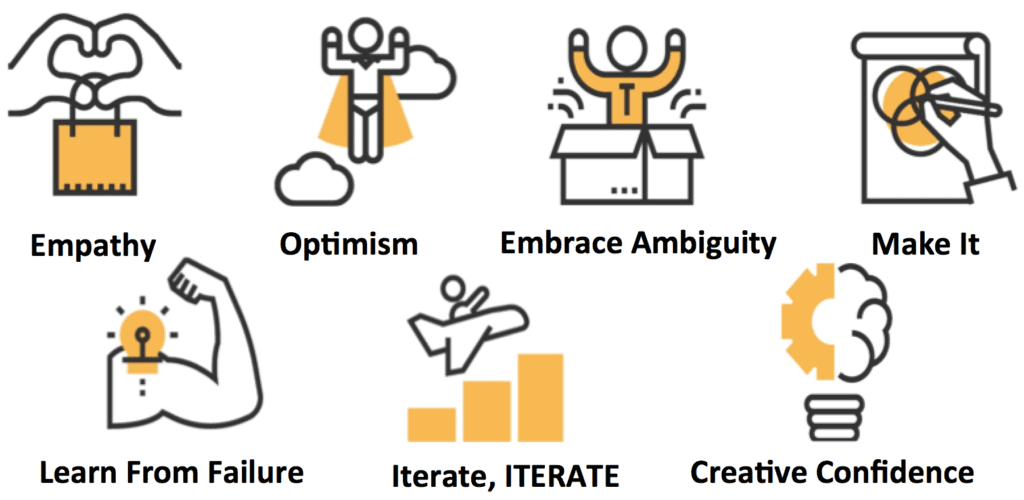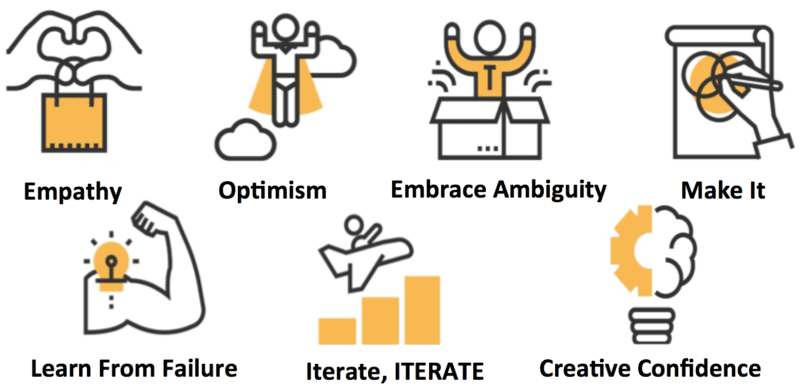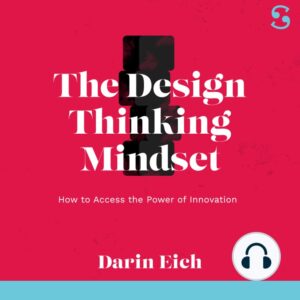Discover these design thinking mindsets that empower innovation.
Design thinking, the popular approach to innovation, requires a certain type of mindset. People who want to innovate their work and create better experiences, products and services for their users or customers might benefit from applying certain attitudes that can empower their thinking and creativity. Here is our collection of design thinking mindsets from leaders IDEO, Stanford d.school, and PDMA to inspire your design thinking activities. You can also dive deeper on this topic in our very short Scribd audio book: The Design Thinking Mindset.
IDEO’s Human-Centered Design Mindsets
Learn from Failure
This mindset is all about the ability to learn from failure and use failure as a tool to improve your practices. As Tim Brown, CEO of IDEO explains, “Don’t think of it as failure, think of it as designing experiments through which you’re going to learn.” Design begins with not knowing the solution to a challenge. Instead of being scared of failure, use every opportunity to experiment and grow from your mistakes.
Make It
Design thinking is about experimenting with prototypes. Make an idea real in order to better understand it and think through the problem. Only through building and testing will you be able to know if a product or service is doing what it should do. Whether it’s a simple cardboard and scissors model, or a sophisticated digital mockup, creating a prototype will allow you to share your idea and gain feedback early and often.
Creative Confidence
This mindset is about approaching the world like a designer. It’s understanding that you have creative ideas and the power to turn those ideas into a reality. Creative confidence allows designers to make leaps and trust their instincts about real solutions to business problems.
Empathy
Empathy is not only a wonderful skill for understanding your customers better, it can also help you solve problems from their perspective and gain insight into the design process. Ultimately, your product or service should be built to help improve other people’s lives and experiences, so never losing sight of an empathetic view of the world is key.
Optimism
IDEO describes design thinking as inherently optimistic. In order to take on a design challenge, you need to believe that progress is an option. Optimism is this embracement of possibility and knowledge that there is a better solution to the problem out there.
Embrace Ambiguity
Design thinking designers start from not knowing the answer to the problem. This ambiguity may feel uncomfortable at first, but by embracing it, you will be able to open yourself up to creative ideas and arrive at unexpected solutions.
Iterate, Iterate, Iterate
The final IDEO design thinking mindset is about iteration. In order to reach the right solution, you need to receive feedback from customers early and frequently. By constantly improving and refining your work, you will be able to produce better ideas and arrive more quickly at the right solution.

Stanford d.school Design Thinking Mindsets
The Stanford d.School was the original source where we first learned of mindsets for design thinking years ago. They’ve also updated them over the years…a previous favorite of mine was “prototype toward a solution.” Here are the Stanford d.school mindsets…similar to IDEO’s human-centered design mindsets as both the Stanford d.school and IDEO have similar Palo Alto/Kelley roots.
Show, Don’t Tell
Like IDEO, the Stanford d.school heavily promotes the idea of using prototypes and real models to illustrate your creative ideas. The “show, don’t tell” mentality is about communicating your vision through the use of experiences, visuals and stories.
Focus on Human Values
Empathy is another important mindset at play here. By focusing on the people you are designing for, you can unlock new ideas you never would’ve thought of without a human-centered approach.
Craft Clarity
Take away all the clutter and explain your idea clearly and simply. Have a vision that others can understand quickly and that can inspire action.
Embrace Experimentation
Prototyping helps you learn and think. It’s not always just about validating an idea or gaining evidence of the right solution. It can also simply help to take action on an idea to understand it better.
Be Mindful of Process
Always remember where you are in the design process, what you are hoping to accomplish and what you need to do next. Allow the design thinking process to guide your actions from start to finish.
Bias Toward Action
This mindset means that you are more focused on action than thinking. Instead of talking about an idea, you will take that idea and turn it into reality. By doing, we learn so much more about the process and how to improve it in the future.
Radical Collaboration
This final Stanford d.school mindset is about the need for collaboration. Amazing designers know that it takes many people from all backgrounds and experiences to truly understand a problem and evolve the solution.
As leaders in the design thinking movement from Palo Alto, IDEO and the Stanford d.school both have powerful insights into the design thinking process and which design thinking mindsets are needed to empower innovation. Hopefully, these mentalities will inspire you to improve your own processes and kickstart creativity at your organization today to design better experiences for those you serve.
Design Thinking Mindsets from PDMA’s Design Thinking Book
In the book, Design Thinking: New Product Development Essentials from the PDMA, Michael Luchs identifies six common principles of the design thinking mindset and philosophy. The six are:
People-centric
This design thinking mindset is about designing and building for people. Keeping your audience in mind during ideation is incredibly useful to find the right solution to overcome a problem or challenge.
Cross-disciplinary and Collaborative
Innovation is, by necessity, a collaborative endeavor. It should also cross disciplines and areas to unlock new and creative solutions to challenge-based problems.
Holistic and Integrative
During the design thinking process, you may be looking to connect seemingly separate ideas or concepts into one. By looking beyond the individual pieces, you can begin to analyze the big picture and how everything can work together holistically as one.
Flexibility and Comfort with Ambiguity
Being comfortable with the ambiguous nature of ideation and the creative process is another useful mindset. Flexibility allows you to look at proposed solutions from many different angles and learn on the spot from the teachings of research, real-life experience, or simulated results.
Multimodal Communication Skills
Multimodal communication combines written, audio, and visual forms to convey an idea or solution. The skill to think in different ways and to use all available tools and methods at your disposal is part of this creative thinking mindset.
Growth Mindset
A mindset for growth means being comfortable with change. Innovation requires pushing past the boundaries of how something has always been done to look at a problem in a new light.
The list of mindsets related to design thinking keep growing and changing. Carol Dweck’s research and popular book on “growth mindset” is a good general mindset view to learn about before diving deeper into the specific innovative mindsets of design thinking listed above.
Design Thinking Mindsets from The Design Thinking Toolbox
In the book The Design Thinking Toolbox: A Guide to Mastering the Most Popular and Valuable Innovation Methods, the author outlines the beginner’s mind as a useful design thinking mindset.
The Beginner’s Mind
The beginner’s mind requires participants to clear their mind and put themselves in the place of someone who knows nothing about the subject at hand. We are essentially becoming “aliens” from another planet who are viewing the situation for the first time. This mindset allows you to remove:
- Prejudices about how something works
- Expectations about what will happen
As well as give you the ability to:
- Understand things more deeply
- Be open to a world of possibilities
- Fail early and often to learn quickly
Other Mindsets
The book also describes a series of other characteristics essential for a mindset of design thinking and innovation, including:
- Starting with human beings, their frustration and needs
- Collaboration with interdisciplinary teams
- Experimentation and prototyping
- Visualization and showing of ideas
- Accepting and embracing complexity
Design Thinking Mindsets from Designing Your Life and Work Life
Bill Burnett and Dave Evans from the Stanford D School wrote the popular books Designing Your Life and Designing Your Work Life. Here are a few mindsets they share as the most valuable in innovation work:
Curiosity
Curiosity is all about exploration. Do something new, deviate from your norm, and try to connect with things in life that you wouldn’t normally. This approach to life can help you find solutions you didn’t think of before.
Bias to Action
This is a commitment to building your way forward. Instead of just reading about something, try it out. Prototyping and experimenting are essential to the innovation process.
Reframing Problems
Reframe a problem when you get stuck to help you move forward in the process. Avoid the “woe me” framework and keep working at it. Don’t worry about having all the answers just yet.
Awareness
Be aware of the process and the nature of innovation as messy, complex, and unpredictable.
Radical Collaboration
The best innovators understand that they are not alone and know when to ask for help. Your life, work, and design thinking challenges are collaborative processes.
What themes do you notice across the different design thinking mindset collections?
What are your favorite mindsets for design thinking? What else would you add?
Contact us to learn about our design thinking mindset workshop. For more resources, tips, and tricks, keep reading our design thinking and innovation resource blog.

